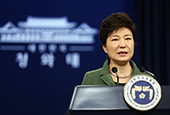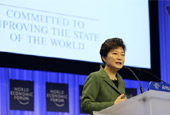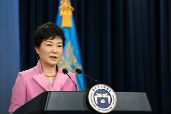Media and investment banks alike have recently given high marks to the government’s Three-Year Plan for Economic Innovation. News outlets report that the three-year plan is based on the correct diagnosis of the structural problems in the Korean economy and that it is expected to boost domestic demand, improve deregulation and raise Korea’s potential economic growth rate.
Calling the plan a, “dose of bold structural reforms to lift the growth trend,” the reports said that a 4 percent annual growth rate is realistic and achievable and that the three-year plan is, “a reform package that could become a model for the region and many other parts of the world.”
President Park Geun-hye announced the three-year plan on February 25 on the first anniversary of her inauguration. It aims to raise Korea’s potential economic growth rate back to over 4 percent, achieve an employment rate of 70 percent and lay the foundation to increase the country’s gross domestic product (GDP) per capita to $30,000 and then to $40,000, her so-called “474 vision”.
William Pesek, a Bloomberg View columnist, praised the plan in a column published on March 3, saying President Park’s policy is focusing on the long term rather than seeking short-term remedies.
“Her ‘474 vision’ is more plausible than many pundits, business people and even her own policymakers seem to think,” wrote Pesek. “It’s also promising that Park is focusing on the long run, not short-term Band Aids, such as easy money or massive stimulus,” as its neighboring countries have done.
Earlier, in an article from February 25, Bloomberg commented that this is what the Korean economy needs: a dose of bold structural reforms to improve growth. “Boosting the service industry could help Park lower the economy's dependence on exports and lift growth potential to her target of 4 percent over the next three years,” it said.
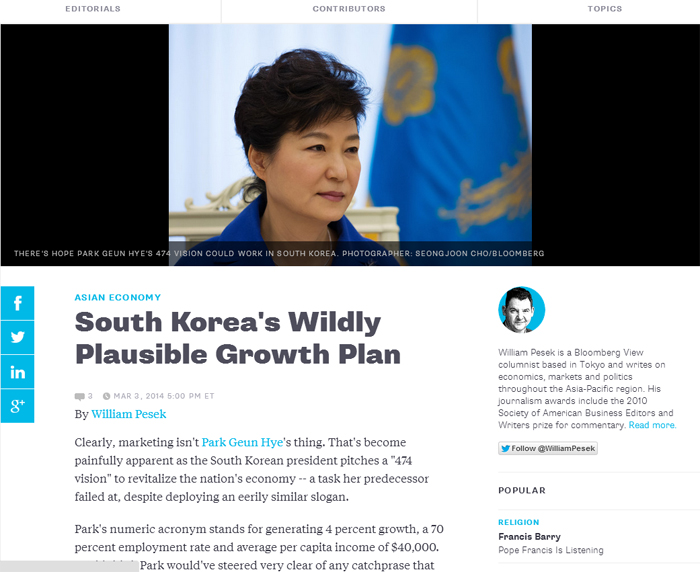
The Wall Street Journal said in an editorial published on February 27 that President Park’s reform package could be a model for the region and for many other parts of the world. “The message is that Koreans will have to work harder to grow in the future, and that government should get out of the way to let them do it. That's exactly right for any economy, but especially one at Korea's stage of development. President Park’s proposal is a breakthrough in its focus on boosting productivity,” it reported.
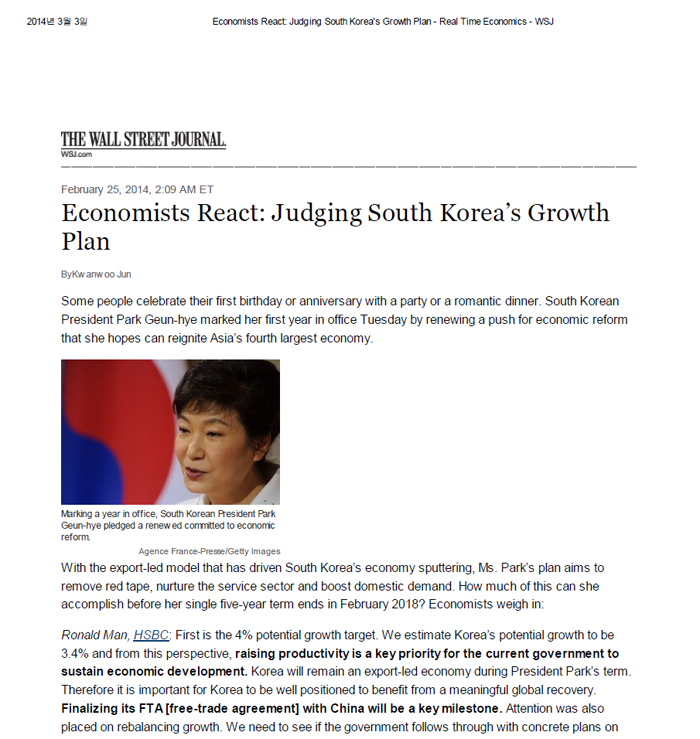
Foreign investment banks praised the Park administration’s three-year plan, too, saying that it is a long-term policy designed to lift the country’s potential growth rate and that the goal is realistic.
Ronald Man, an HSBC economist, was quoted as saying that, “President Park has demonstrated that she's determined to take large strides in strengthening Korea's potential growth rate. Given that the economic theme in Asia is centered on reforms, the political will to deliver and boost potential growth may be stronger now than before."
Wai Ho Leong, an economist at Barclays, on February 26 compared Korea’s three-year plan with economic policies in neighboring countries and said that Korea's reform path is more comprehensive and actionable. “There is significant political will to drive the structural reform agenda,” he said.
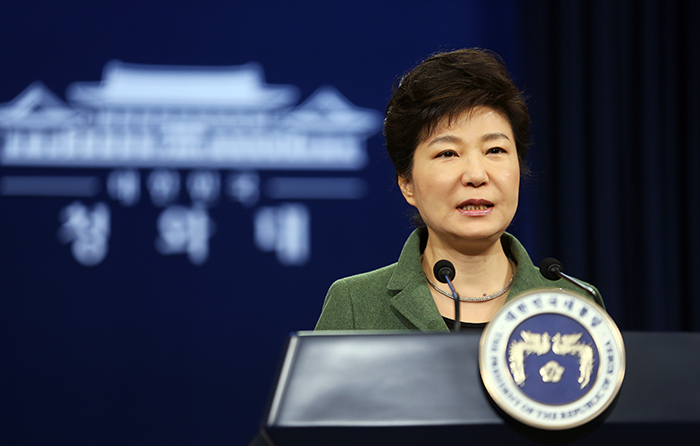
In an earlier report on February 25, Barclays said, “What is also clear is that the emphasis of policy has shifted decisively toward structural reform and away from short term growth boosters, such as fiscal and monetary policy. We continue to expect growth to accelerate to 4.1 percent in 2014 and 4.2 percent in 2015, as investment's contribution to overall growth increases. The target of raising potential growth to 4 percent by 2017 is realistic, in our view."
On February 28, ANZ senior economist Raymond Yeung said in an interview with The Diplomat, a Japanese journal, that the three-year plan showed, "a correct diagnosis of the key challenges clouding growth prospects for Korea."
JP Morgan said in a report on February 25 that the Korean government is laying down the proper framework for the country's long term initiatives.
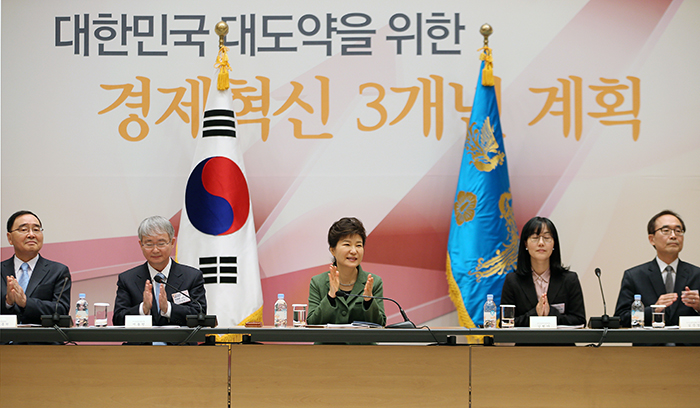
In a meeting with Deputy Prime Minister Hyun Oh-seok last month, Asian Development Bank President Nakao Takehiko said that Korea’s three-year plan will become a new development model for Asian nations, as it shows that Korea is not settling for its present but is seeking development through reform.
Takehiko showed strong support for the plan, saying, “The three-year plan has clear goals and seeks economic structural reform.”
By Limb Jae-un
Korea.net Staff Writer
jun2@korea.kr

Calling the plan a, “dose of bold structural reforms to lift the growth trend,” the reports said that a 4 percent annual growth rate is realistic and achievable and that the three-year plan is, “a reform package that could become a model for the region and many other parts of the world.”
President Park Geun-hye announced the three-year plan on February 25 on the first anniversary of her inauguration. It aims to raise Korea’s potential economic growth rate back to over 4 percent, achieve an employment rate of 70 percent and lay the foundation to increase the country’s gross domestic product (GDP) per capita to $30,000 and then to $40,000, her so-called “474 vision”.
William Pesek, a Bloomberg View columnist, praised the plan in a column published on March 3, saying President Park’s policy is focusing on the long term rather than seeking short-term remedies.
“Her ‘474 vision’ is more plausible than many pundits, business people and even her own policymakers seem to think,” wrote Pesek. “It’s also promising that Park is focusing on the long run, not short-term Band Aids, such as easy money or massive stimulus,” as its neighboring countries have done.
Earlier, in an article from February 25, Bloomberg commented that this is what the Korean economy needs: a dose of bold structural reforms to improve growth. “Boosting the service industry could help Park lower the economy's dependence on exports and lift growth potential to her target of 4 percent over the next three years,” it said.

A Bloomberg columnist called the three-year plan more “plausible” than many people think, on March 3.
The Wall Street Journal said in an editorial published on February 27 that President Park’s reform package could be a model for the region and for many other parts of the world. “The message is that Koreans will have to work harder to grow in the future, and that government should get out of the way to let them do it. That's exactly right for any economy, but especially one at Korea's stage of development. President Park’s proposal is a breakthrough in its focus on boosting productivity,” it reported.

The Wall Street Journal reported on February 25 that President Park Geun-hye has demonstrated that she is determined to take large strides to strengthen Korea’s potential growth rate.
Foreign investment banks praised the Park administration’s three-year plan, too, saying that it is a long-term policy designed to lift the country’s potential growth rate and that the goal is realistic.
Ronald Man, an HSBC economist, was quoted as saying that, “President Park has demonstrated that she's determined to take large strides in strengthening Korea's potential growth rate. Given that the economic theme in Asia is centered on reforms, the political will to deliver and boost potential growth may be stronger now than before."
Wai Ho Leong, an economist at Barclays, on February 26 compared Korea’s three-year plan with economic policies in neighboring countries and said that Korea's reform path is more comprehensive and actionable. “There is significant political will to drive the structural reform agenda,” he said.

President Park Geun-hye announces the Three-Year Plan for Economic Innovation on February 25 on the first anniversary of her inauguration. (photo: Cheong Wa Dae)
In an earlier report on February 25, Barclays said, “What is also clear is that the emphasis of policy has shifted decisively toward structural reform and away from short term growth boosters, such as fiscal and monetary policy. We continue to expect growth to accelerate to 4.1 percent in 2014 and 4.2 percent in 2015, as investment's contribution to overall growth increases. The target of raising potential growth to 4 percent by 2017 is realistic, in our view."
On February 28, ANZ senior economist Raymond Yeung said in an interview with The Diplomat, a Japanese journal, that the three-year plan showed, "a correct diagnosis of the key challenges clouding growth prospects for Korea."
JP Morgan said in a report on February 25 that the Korean government is laying down the proper framework for the country's long term initiatives.

President Park Geun-hye (middle) applauds after she announces the Three-Year Plan for Economic Innovation on February 25 on the first anniversary of her inauguration. (photo: Cheong Wa Dae)
In a meeting with Deputy Prime Minister Hyun Oh-seok last month, Asian Development Bank President Nakao Takehiko said that Korea’s three-year plan will become a new development model for Asian nations, as it shows that Korea is not settling for its present but is seeking development through reform.
Takehiko showed strong support for the plan, saying, “The three-year plan has clear goals and seeks economic structural reform.”
By Limb Jae-un
Korea.net Staff Writer
jun2@korea.kr
Related Contents
Most popular
- Slew of festivals, events scheduled in downtown Seoul in May
- Actor Tom Cruise proves 'love for Korea' with 12th visit
- Netflix releases official trailer for final season of 'Squid Game'
- Jeju Island completes prep to host series of APEC meetings
- KRW 26T deal confirmed for 2 nuke plants in Czech Republic
